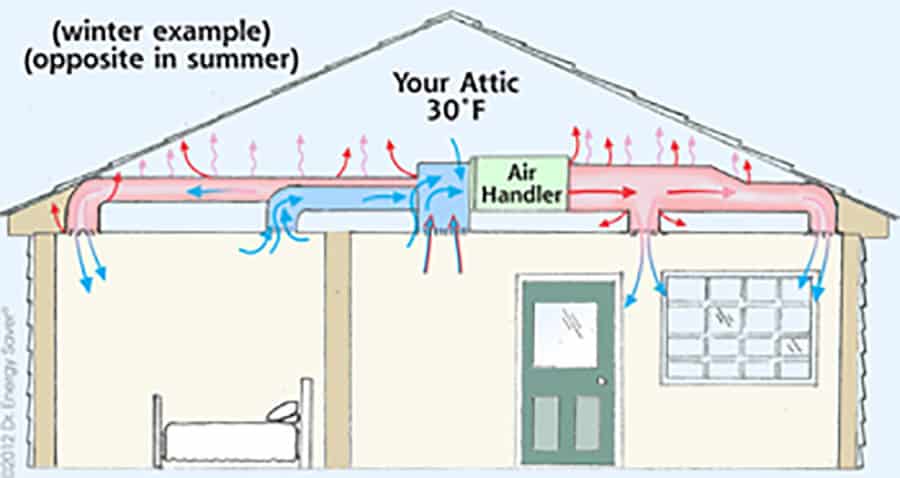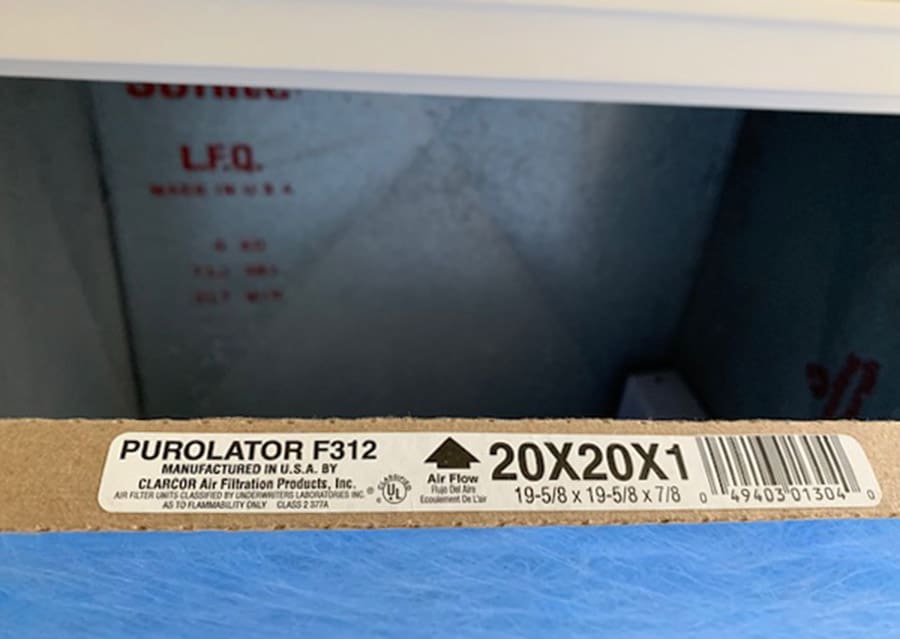
We all do it without thinking about it. We swap out or air filters in our home without giving it much thought. However, there is a correct way to install your home’s air filter, and installing it backward can waste money and cause long-term damage to your system if you’re not careful.
So, what happens if your air filter is installed wrong? Air filters are constructed to be installed in a certain direction. Installing your air filter backward can restrict airflow through the air filter, cause the filter structure to fail, and allow dust, dirt, and other debris to get past the filter and collect on the evaporator coil. If your evaporator coil gets dirty, your system won’t work at optimal efficiency and could clog your condensate discharge pipe causing your system to fail.
To understand what happens if your air filter is installed wrong, we need to first understand how airflow works in a home’s ductwork. Let’s talk for just a moment about that. The cycle is relatively simple.
Indoor Air –> Return Vent –> Return Duct –> Furnace or Air Handler –> Supply Ducts –> Supply Registers –> Back Into House

In the illustration above, you’ll see the airflow a little clearer. The air handler contains a blower fan. The blower fan sits at the opening to the air handler and blows in the direction of the supply duct. As the blower fan blows towards the supply duct, it’s drawing air through the return duct from inside the house. Here are the steps:
- The blower fan turns on and begins blowing air towards the supply ducts.
- As the blower is running the fan draws air from the return duct.
- Thus air flows from inside the house across the evaporator coil located inside the air handler.
- The air is heated or cooled before it flows into the supply ducts and then back into the house.
- This cycle repeats itself continually creating air circulation inside the house.
So what does all this have to do with whether or not the air filter is installed wrong. I promise we are getting there. Stay with me.
Why Do Air Filters Have Direction Arrows

Air filters have direction arrows to indicate which direction to install the air filter in the return. The directional arrow points in the direction of the airflow which is into the return duct. The filter is installed with the arrow facing into the air return. In other words with the filter is installed in the direction with the airflow, not against it.
Air passes through the air filter which (depending on the type of air filter you have) catches dust, dirt, and other airborne contaminants. If no air filter is present in the air return, these airborne contaminants end up collecting on the evaporator coil.
When the evaporator coil gets dirty, the system loses energy efficiency. Condensation created at the evaporator coil picks up debris off the coil and flows into the condensate discharge pipe.
Over time, this can stop up the discharge pipe preventing condensation from flowing which can cause the evaporator coil to fail or worse create a leak causing damage to the interior of your home.
If you need a complete guide to replacing your air filters, we put together an article How To Locate & Replace Your Heat Pump Filter: Step By Step Guide to help you along the way. It’s a simple process, but can be scary for a first-time homeowner who knows nothing about home maintenance.
Which Way to Put Your Filter In
In addition to looking at the directional arrows, all air filters are constructed a certain way based on the type of filter it is and how long it’s designed to last. Disposable air filters are not meant to last longer than 3 months. Some only last about 1 month. Let’s look at both.
Fiberglass – basic inexpensive filters the come white, blue, or green in color depending on the manufacturer. These filters should be changed every 30 days.
Most fiberglass filters have little to no structure material like pleated filters woven into the filter material except for the cardboard frame. Under the drawing pressure of the blower fan, these filter structures will eventually fail over time, resulting in the cardboard filter frame bending or even buckling into the return box. When this happens the filter has failed and airborne contaminants are free to flow directly to the evaporator coil.
Polyester or Pleated – are made with thicker materials and designed to capture more airborne contaminants depending on the MERV rating. These filters need to be replaced every 3 months.
Pleated filters have support is woven into the filter material, usually metal or plastic cording which helps the filter to stand up to the pressure from the blower fan. These filters will last approximately 3 months, however, they can still fail, resulting in the filter frame bending or even buckling into the return box. When the filter fails, airborne contaminants can collect on the evaporator coil.
What to do If My Air Filter Has Failed
If you’ve not replaced your air filter in several months you may be ok. However, if this is a habitual event, you will need to get your HVAC system examined by a licensed HVAC contractor and get your HVAC back on a routine maintenance schedule.
Even with proper air filter maintenance, you should have your HVAC system cleaned and serviced at least once per year. Air filters, especially the basic ones, capture large airborne particles but allow many smaller particles to pass through them.
Over time, these particles collect on the evaporator coil and can only be removed by a professional. I’ve seen many systems fail due to neglected service.
If your evaporator coil is really dirty from neglect, you will also need to get the ducts cleaned. Cleaning the ducts removes contaminants that have built up over time on the inside walls of the ducts.
Dirty ducts will cause you to have to replace your air filters sooner than you normally should have too. This is a sign that something is not right and you should have your HVAC system and ducts examined.
According to HomeAdvisor’s 2020 data, you can expect to pay between $75 – $200 for an HVAC tune-up. They state that a tuneup generally includes cleaning the outside condenser but not the evaporator coil. You should expect to pay an additional $50-$100 per hour for a technician to service and clean your HVAC system.
In a separate study, HomeAdvisor states that the ducts should be cleaned every 5-7 years and you can expect to pay an average $368, or between $268 and $483. If you have a larger home you could pay as much as $700 for duct cleaning.
In Conclusion
In closing, let me state that while these costs may seem high, a properly maintained HVAC system can last you 20 or more years. I’ve seen many HVAC systems still working great after 30 years.
It really all comes down to, if you take care of the HVAC system, it’ll be there when you need it. It all starts with understanding how your HVAC system works and making sure that your air filters are properly installed and replaced on a regular basis.
On a final side note, many homeowners like to cover their return air vents because they don’t like how it looks. This can also be detrimental to your heat pump. To help, we’ve put together 10 Ways to Hide Your Return Vent Without Blocking Airflow.







